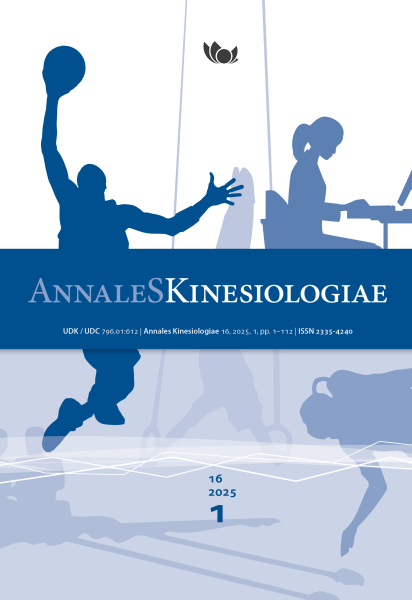High-intensity interval exercise enhances vascular function to a greater extent than moderate-intensity continuous aerobic exercise
A case study report
DOI:
https://doi.org/10.35469/ak.2025.520Keywords:
HIIT, MICT, endothelial function, pulse-wave velocity, endothelial stiffnessAbstract
This case study compared the acute effects of high-intensity interval training (HIIT) and moderate-intensity continuous training (MICT) on vascular and microvascular function in a healthy male subject (age: 34 yrs; body mass index: 25.82 kg/m2). Key vascular parameters were assessed, including augmentation index (AIx), carotid-femoral and brachial-ankle pulse wave velocity (cfPWV, baPWV), flow-mediated slowing (FMS%), and tissue saturation index (TSI) recovery slope. HIIT induced a greater reduction in baPWV (mean difference [MD]: 0.9 m/s) and a higher increase in FMS% (MD: 8%) compared to MICT, indicating more favourable changes in peripheral arterial stiffness and endothelial function. Additionally, the reoxygenation slope for TSI was more pronounced after HIIT, suggesting improved microvascular recovery. Interestingly, AIx increased following MICT (MD from baseline: 11%) but slightly decreased after HIIT (MD from baseline: −5%). These findings suggest that exercise intensity plays a critical role in determining vascular adaptations, with HIIT showing superior acute benefits.
Downloads
Downloads
Published
How to Cite
Issue
Section
License
Copyright (c) 2025 Armin Paravlić, Simon Iskra, Gašper Turnšek, Kristina Drole

This work is licensed under a Creative Commons Attribution 4.0 International License.
Open Access Policy and Copyright
This journal provides immediate open access to its content on the principle that making research freely available to the public supports a greater global exchange of knowledge. Users are allowed to read, download, copy, distribute, print, search, or link to the full texts of the articles, or use them for any other lawful purpose, without asking prior permission from the publisher or the author.
Authors who publish with this journal agree to the following terms:
- Authors retain copyright and grant the journal right of first publication with the work simultaneously licensed under the terms of the Creative Commons Attribution license (CC BY) that allows others to share the work with an acknowledgement of the work’s authorship and initial publication in this journal.
- Authors grant the publisher commercial rights to produce hardcopy volumes of the journal for sale to libraries and individuals.
- Authors are able to enter into separate, additional contractual arrangements for the non-exclusive distribution of the journal’s published version of the work (e.g., post it to an institutional repository or publish it in a book), with an acknowledgement of its initial publication in this journal.








